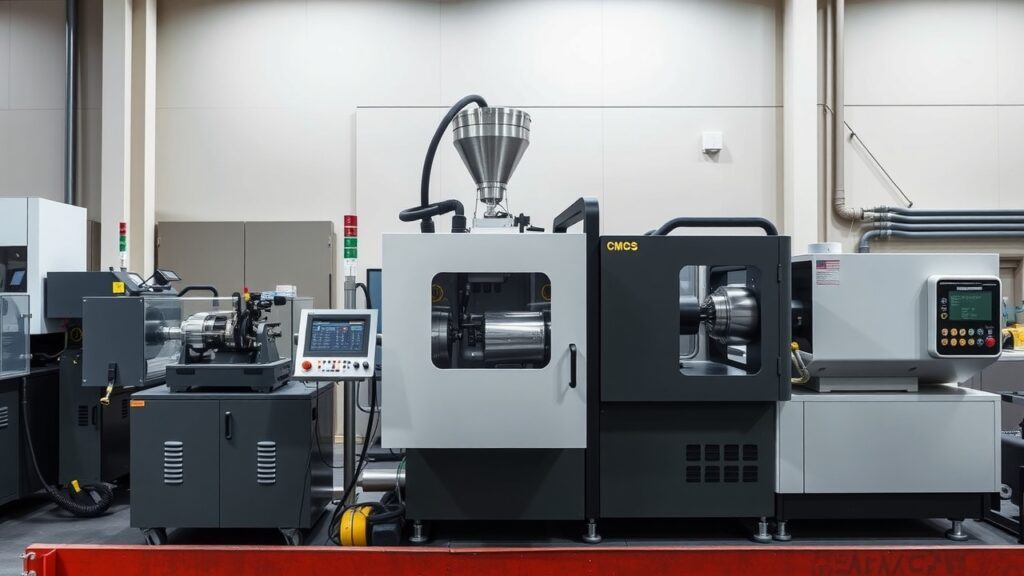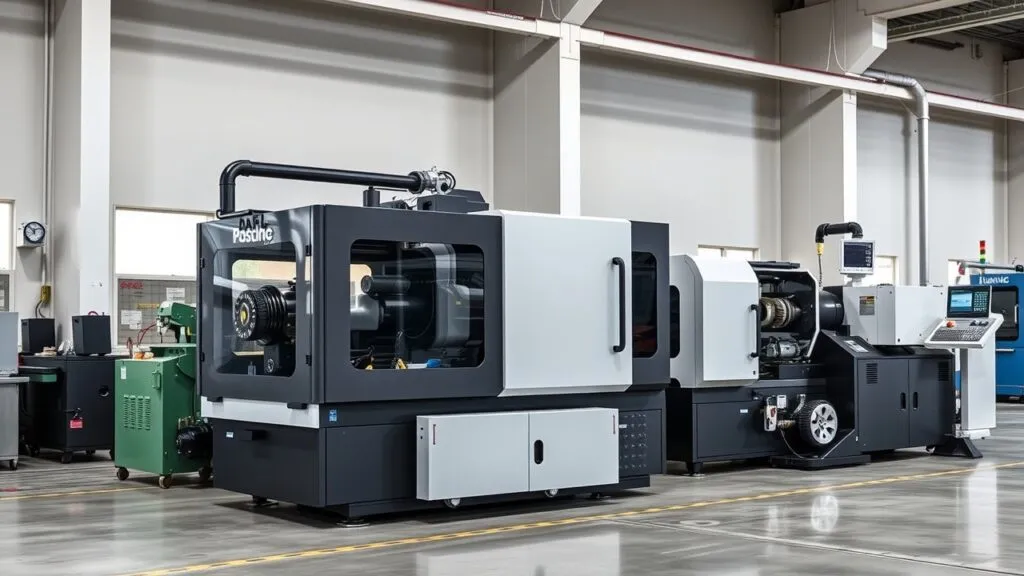Types of injection molding machines vary greatly; this guide covers injection and clamping systems, providing a helpful overview of plastic injection mold manufacturing.
What Are Injection Molding Machines?

Injection molding machines play a key role in making plastic parts. They help with the injection molding process, which is all about melting plastic and injecting it into a mold to create different shapes and components. This method is popular because it works well and produces lots of products that are consistent in quality.
The injection molding process has a few important steps:
- Melting: Plastic pellets get heated until they become liquid.
- Injecting: The liquid plastic goes into a mold under high pressure.
- Cooling: After filling the mold, the plastic cools down and hardens into the desired shape.
- Ejecting: Once it’s cooled, the finished part is pushed out of the mold for further use or assembly.
Grasping these steps can help you understand how various types of injection molding machines work in this setting.
Why Is It Important to Understand Different Types of Injection Molding Machines?
Knowing about the different types of plastic injection molding machines can greatly affect how efficiently you produce items, save on costs, and maintain product quality. Each machine type has its own perks that can change outcomes based on project needs.
Here are some factors to think about when choosing an injection molding machine:
- Material Type: Different materials may need specific machine features for best results.
- Part Complexity: Complex designs might need advanced machines that allow for precise control.
- Volume Requirements: For high production rates, specialized machines designed for speed can be very helpful.
By keeping these aspects in mind, manufacturers can make choices that boost productivity while still keeping quality high.
Horizontal Injection Molding Machines Explained
Horizontal injection molding machines are widely used in manufacturing, especially for producing plastic parts in large quantities. These machines inject molten plastic into molds that lie flat. This design makes them effective for many applications across various industries.
How Do Horizontal Injection Molding Machines Work?
Horizontal injection molding machines operate through a series of steps in the injection molding process. First, raw plastic pellets go into a heated barrel. Inside, they melt thanks to electric or hydraulic heat. The machine uses screw technology, specifically reciprocating screws, to move the melted plastic towards the mold.
Once the pressure inside the barrel is high enough, the molten plastic is injected into a heated mold at high pressure. This precise filling helps reduce defects in the finished products. After cooling, the mold opens to release the final items.
Advantages & Disadvantages of Horizontal Designs
Horizontal machines have several benefits and some drawbacks:
Pros:
- Easy access to molds for maintenance and cleaning.
- Well-suited for high-volume production; they can produce many parts quickly without losing quality.
Cons:
- They need more floor space than vertical machines since they require room for operation and for loading materials as well as unloading products.
Best Applications for Horizontal Models
Horizontal injection molding machines are perfect for various applications:
- They are commonly used in making automotive parts like dashboards and bumpers due to their ability to create complex shapes accurately.
- These machines also excel in producing large consumer goods, such as containers and household appliances, efficiently.
Understanding how horizontal injection molding machines work is essential for recognizing their efficiency and application in different industries.
Vertical Injection Molding Machines Overview
Vertical injection molding machines serve a different purpose compared to horizontal ones. They feature a compact design with vertically aligned clamping units, making them unique.
How Do Vertical Injection Molding Systems Operate?
Vertical systems operate by aligning molds vertically. This orientation allows parts to be inserted directly into the mold without needing additional equipment. The design saves space while ensuring precise molding.
Key Benefits & Drawbacks
Vertical injection molding machines come with advantages and limitations:
Pros:
- Their smaller footprint makes them suitable for tight spaces.
- Effective for insert molding or overmolding components that require precision during production.
Cons:
- They have limited capacity when it comes to larger molds or parts compared to horizontal setups.
Common Use Cases
Vertical machines are often preferred in specific sectors:
- In medical devices manufacturing, where accuracy is critical.
- They are also widely used in electronics due to their precision requirements.
Understanding these differences helps businesses choose the right machine type based on their production needs.
Exploring Platen-Based Designs
Two-Platen
How Do Two-Platen Systems Work?
Two-platen injection molding machines are designed to separate the clamping and injection processes. This system uses two platens: one holds the mold while injecting plastic, and the other provides the clamping force during cooling. This setup gives flexibility in mold design, allowing for larger molds without needing much space.
Hydraulic injection molding machines that operate on this principle apply pressure through hydraulic cylinders. This control over clamping force is essential for optimizing cycle times and ensuring consistent part quality. Moreover, two-platen systems often provide easier access to the mold area, which simplifies maintenance and setup changes.
Advantages and Disadvantages of Two-Platen Systems
Two-platen systems have several benefits. They are compact compared to traditional four-platen designs, which saves floor space. They also offer quicker cycle times thanks to efficient clamp movements and lower energy use with modern hydraulic technology.
However, these systems have some drawbacks. They may face limits on maximum shot sizes or need more complex controls than simpler models. Additionally, they might not work well with all types of plastic materials or intricate mold designs due to potential issues with uniform filling.
When choosing a plastic injection molding machine, knowing these pros and cons helps manufacturers make better decisions based on their production needs.
Applications of Two-Platen Systems
Two-platen systems are used in many industries, including industrial manufacturing and automotive sectors where precision is crucial. Their ability to manage large molds makes them suitable for creating parts like automotive dashboards or housings that require high dimensional accuracy.
These machines are also valuable for applications requiring fast production cycles, such as consumer goods manufacturing, where getting products to market quickly is key. Overall, their versatility makes them popular across various sectors in modern manufacturing.
Three-Platen
How Do Three-Platen Systems Work?
Three-platen injection molding machines feature a setup that improves efficiency and precision. They have three distinct platens: one fixed platen attached to the machine frame, a moving platen that injects material into the cavity, and an intermediate platen that supports the process.
This configuration allows screw injection molding machines using three platens to control clamping forces effectively at different stages—leading to better performance than single-plate setups or some dual-plate options.
By spreading stress evenly across all surfaces during each phase—from heating through cooling—these designs reduce wear while maximizing output consistency across various products, from small electronic enclosures to larger components used in heavy machinery.
Advantages and Disadvantages of Three-Platen Systems
Three-platen designs offer notable benefits such as improved energy efficiency thanks to optimized mechanical linkages that cut down unnecessary power consumption. Additionally, they allow for easier changeovers between jobs, boosting productivity under tight deadlines.
On the flip side, these systems can come with higher initial costs compared to more conventional options. This requires careful thought before fully committing resources to implement such advanced machinery.
Applications of Three-Platen Systems
The strengths of three-platen systems are especially useful in fields that require precise engineering standards. These include medical device fabrication and electronics assembly where strict tolerances must be met due to industry regulations ensuring safety and reliability.
With continuous advancements in technology, three-platen systems adapt quickly to changing market demands. As a result, they help manufacturers meet expectations efficiently while providing high-quality products that comply with necessary standards.
Two-Platen vs.Three-Platen
When comparing two-platen and three-platen designs, each system has unique features that cater to different manufacturing needs. Factors like floor space requirements, energy efficiency, initial investment costs, and specific application demands play vital roles in choosing the right system.
Understanding these differences can help businesses select the best option tailored to their production goals while optimizing performance in their manufacturing processes.
Drive Systems: Hydraulic, All-Electric, and Servo-Hydraulic
Hydraulic Injection Molding Machines
Hydraulic injection molding machines use a hydraulic system to create the necessary force for the injection process. These machines deliver strong clamping forces and accurate control over injection pressure. They work well in various manufacturing applications.
Operation
Hydraulic systems operate by turning hydraulic energy into mechanical energy. A hydraulic pump creates flow that moves pistons inside cylinders. This action generates the clamping force needed to keep molds closed during the injection phase. This system also allows for high plasticizing capacity, ensuring efficient melting and injecting of thermoplastics.
Advantages
The main benefits of hydraulic systems include cost-effectiveness in production. They can achieve fast injections due to their quick fluid dynamics responses. Also, these machines typically have lower initial costs compared to all-electric options while still providing strong performance with different materials.
Disadvantages
Even with their advantages, hydraulic systems have some downsides. They tend to consume more energy than other types since pumps run continuously, even when not injecting material. Moreover, maintenance can increase as parts wear out from constant use.
Applications
Hydraulic injection molding machines are commonly used in several industries. Key applications include automotive parts manufacturing and industrial equipment production. Their ability to produce large quantities efficiently makes them ideal for creating complex components like housings or structural parts used in vehicles and machinery.
All-Electric Injection Molding Machines
All-electric injection molding machines function using electric drive systems instead of hydraulics or pneumatics. This technology enhances precision through automation and helps reduce environmental impact by lowering energy consumption.
Operation
In an all-electric machine, servo motors control each axis independently. This allows for fine-tuned adjustments during processes like injection speed control and mold temperature management. The high level of automation results in better cycle times and product consistency throughout production runs.
Advantages
The benefits of all-electric systems include significant savings on energy costs because they only use power when necessary. Additionally, there is less need for maintenance due to fewer moving parts compared to traditional designs, leading to reduced downtime and increased productivity overall.
Disadvantages
However, all-electric models do have limitations, especially regarding higher initial investment costs compared to conventional options. This might discourage some manufacturers despite potential long-term savings from increased efficiency after installation.
Applications
Common applications for all-electric models include electronics manufacturing where precision is crucial and medical device production that requires strict quality controls to ensure safety standards without sacrificing output rates.
Servo-Hydraulic Injection Molding Machines
Servo-hydraulic injection molding machines combine servo motor technology with traditional hydraulic setups. These hybrid solutions leverage the strengths of both methods while addressing the weaknesses inherent in each approach.
Operation
These advanced machines use servo motors along with hydraulically driven mechanisms. This setup provides operators with more flexibility tailored to unique project demands. The improved responsiveness leads to optimized cycle efficiencies that positively affect overall performance.
Advantages
The key advantages of servo-hydraulic systems are precise control over processes, which improves part accuracy and reduces scrap rates generated during operations under varying conditions.
Disadvantages
Challenges often arise with servo-hydraulic setups regarding cost implications when compared to traditional methods that have been used for longer periods.
Applications
Servo-hydraulic models are commonly used in aerospace components manufacturing among other applications that benefit from their precision and efficiency capabilities.
Comparison of Drive Systems
When considering drive systems, it’s essential to understand the differences between hydraulic, all-electric, and servo-hydraulic models. Each type has its own unique advantages and drawbacks:
- Hydraulic Systems: Cost-effective but higher energy usage.
- All-Electric Systems: Lower energy costs with higher initial investment.
- Servo-Hydraulic Systems: Precision control but potentially higher costs than traditional setups.
Choosing the right system depends on specific production needs, budget considerations, and desired output quality.
Key Components and Systems
Injection Systems (Screw vs. Plunger): Types, Function, Composition
Injection systems are vital in injection molding machines. They dictate how plastic is melted and injected into molds. The main types are screw and plunger systems.
Screw Injection Molding Machines
Screw injection molding machines use a rotating screw to melt plastic resin in a heated barrel. This method provides some great benefits:
- Plasticizing Capacity: These machines efficiently melt and mix materials, improving product quality.
- Melt Flow Rate: They allow for precise control of the melt flow rate. This precision is key when making complex parts with tight tolerances.
You’ll find different types of screw injection molding machines based on their setup and what they need to do. For example, reciprocating screw models can melt and inject in one smooth process.
Plunger Injection Molding Machines
Plunger injection molding machines operate using a piston-like system that forces hot plastic into molds. They work well for applications where high pressure is needed to fill intricate designs quickly.
Common uses include:
- High-viscosity materials
- Production of large parts
The advantage of plunger systems is their ability to handle thicker materials effectively. However, they may not offer the same precision as screw systems regarding melt flow rates or temperature management.
Clamping Systems (Toggle vs. Hydraulic): Types, Function, Composition
Clamping systems hold the mold in place during operation while allowing for easy opening after cooling. Two main types are toggle and hydraulic systems.
Toggle Clamping Mechanisms
Toggle clamping mechanisms apply force mechanically to close molds. Their benefits include:
- Efficiency in Force Application: They use less energy than hydraulic systems due to mechanical advantage.
- Compact Design: Toggle clamps are smaller than hydraulic ones but still provide necessary clamp tonnage calculations for various jobs.
These features make toggle clamping great for smaller setups or spaces where performance matters without taking up much room.
Hydraulic Clamping Mechanisms
Hydraulic clamping mechanisms use fluid power to exert force on molds during operation. Their efficiency comes from:
- Consistent Pressure Application: Hydraulics keep uniform pressure across large surfaces.
- Adaptability Across Sizes: They work well for larger machines needing substantial clamp tonnage without increasing size much.
Hydraulic systems are typically more powerful than toggle clamps but can have higher maintenance costs because of potential leaks or fluid issues.
Control Systems (Manual, Semi-Automatic, Fully Automatic): Modes, Function
Control systems regulate how an injection molding machine runs from setup to production. This ensures performance meets manufacturing needs.
Manual controls are straightforward but may lack efficiency in high-volume settings. Semi-automatic modes add some automation but still need operator input at critical points. Fully automatic processes boost productivity by reducing human intervention while ensuring output quality through advanced monitoring tech built into modern machines.
Heating and Cooling Systems: Importance for Process Control
Heating and cooling systems are crucial for controlling mold temperatures throughout each cycle phase. These factors significantly influence part quality and processing times in any injection molding machine setup.
Effective heating melts plastics properly before injecting them into molds, while optimized cooling reduces overall cycle time. This leads directly to higher production levels through better thermal management strategies used across various operations.
Safety Monitoring Systems: Components and Functions
Safety monitoring systems consist of components designed to ensure safe operations in plastic processing environments. Features like emergency stop buttons and sensors that detect unusual conditions help establish strong safety protocols that are essential in today’s automated manufacturing settings.
Injection Molding Machine Selection Guide

Factors to Consider
When picking an injection molding machine, it’s crucial to think about several key factors. Knowing the different types of injection molding machines can help you make better choices for your production needs.
Injection Molding Machine Types
There are main types of injection molding machines: hydraulic, all-electric, servo-hydraulic, horizontal, vertical, two-platen, and three-platen systems. Each type has features that can affect how well it fits your project.
- Hydraulic Injection Molding Machines: These machines are popular for their strength and ability to create large parts with high pressure. They use hydraulic fluid for operation.
- All-Electric Injection Molding Machines: These are known for being energy-efficient and precise. They use electric motors instead of hydraulic systems. They’re great for small-to-medium-sized parts that need accuracy.
- Servo-Hydraulic Injection Molding Machines: These machines blend the benefits of hydraulic and electric technologies. They save energy while still being fast and precise.
- Horizontal vs Vertical Injection Molding Machines: Horizontal machines are more common in larger operations because they work well with different part designs and automate easily. Vertical machines are better in smaller spaces or when insert molding is needed.
- Two-Platen vs Three-Platen Systems: Two-platen designs take up less space while providing enough clamping force, making them a good choice for large molds or high production volumes. Three-platen systems can handle heavier molds but require more space.
Key Considerations
- Production Volume: The amount you plan to produce affects which machine to choose. Higher volumes may need faster cycle times that some machines provide.
- Part Design: If your parts have complex shapes, certain machine features can help, like multi-material processing or specialized molds.
- Material Properties: Different materials behave differently when heated, so understanding their properties is important for proper processing.
- Budget Constraints: The costs of different machines vary a lot. Balancing initial purchase prices with long-term maintenance expenses is essential.
- Available Space: The layout of your facility will help determine if a horizontal or vertical machine fits better.
- Automation Needs: As manufacturing moves towards automation, considering how easily the machine can work with automated systems becomes key.
Step-by-Step Decision-Making Process
Choosing the right injection molding machine requires a clear process:
- Define Production Requirements:
- Look at expected production volume based on market trends.
- Determine part specifications including size and complexity.
- Evaluate Material Compatibility:
- Research the materials you’ll use and their properties (like heat stability).
- Analyze Budgetary Limits:
- Think about total costs beyond just buying the machine—look at ongoing maintenance expenses too.
- Review Available Space:
- Measure your workspace to ensure there’s enough room not just for the machine but also for necessary additional equipment like cooling systems or conveyors.
Calculating ROI and Total Cost of Ownership
Understanding what it costs to buy an injection molding machine goes beyond its purchase price:
- Maintenance Costs: Regular maintenance varies by technology type—hydraulic models usually have higher upkeep costs than all-electric ones due to more moving parts that wear out over time.
- Total Cost of Ownership (TCO): TCO includes both direct costs (like the purchase price) and indirect ones such as energy usage that each technology affects profitability during its lifecycle—from initial use until disposal or recycling after production ends.
By examining these factors carefully, you can make informed choices that lead to better returns on investment in your injection molding projects.
Best Practices and Troubleshooting
Best Practices for Operation and Maintenance
Keeping injection molding machines in top shape is key to good performance and product quality. Start with regular inspections of the machine parts. Check hydraulic systems, electrical connections, and mechanical components to spot any issues before they get worse.
Next, set up a scheduled maintenance plan. This plan should include routine tasks like cleaning filters to avoid clogs, lubricating moving parts to cut down friction, and calibrating controls for accurate measurements during the injection molding process. These actions boost machine efficiency and help maintain high standards in plastic injection molding.
Don’t forget about training operators on best practices. Properly trained personnel can run machines efficiently, reducing wear and tear while increasing output quality. When operators know the ins and outs of the injection molding process, they can make smarter choices that improve production speed and lower defect rates.
Troubleshooting Common Injection Molding Problems
Injection molding defects can mess up production schedules and drive costs up if not handled quickly. Here are some common issues and their solutions:
- Short Shots: This problem happens when not enough material is injected into the mold cavity because of low pressure or temperature settings. To fix it, try raising the melt temperature or adjusting the shot size.
- Flashing: Flashing occurs when extra material leaks from between mold halves during injection cycles. This is often due to weak clamp force or too much injection pressure. You can solve this by tightening mold clamps or lowering injection pressure.
- Warping: Warping happens when molded parts cool unevenly, causing distortion after they come out of the molds. To fix this, work on optimizing cooling time or improving airflow around molds.
- Sink Marks: These are surface flaws caused by insufficient packing pressure during cooling that leads to uneven filling of part geometries. Increasing holding pressure usually helps get rid of sink marks.
- Bubbles/Air Traps: Air trapped in molds creates bubbles in the finished products—an important concern for many applications. To reduce this issue, make sure proper venting mechanisms are part of your mold designs.
Knowing best practices for operation and troubleshooting techniques is vital for improving productivity across various types of plastic injection molding machines today. Whether you’re working with horizontal models or specialized electric options used in areas like medical device manufacturing, applying these strategies effectively can lead to better results in your operations.
FAQs about Types of Injection Molding Machines
What are the key types of injection molding machines?
The main types include hydraulic, all-electric, servo-hydraulic, horizontal, vertical, two-platen, and three-platen systems. Each type serves different manufacturing needs.
How do hydraulic injection molding machines operate?
Hydraulic machines use fluid pressure to create strong clamping forces. They excel in high-volume production but consume more energy than electric models.
What are the benefits of all-electric injection molding machines?
All-electric machines are energy-efficient and offer high precision. They reduce maintenance costs due to fewer moving parts.
When should I choose a vertical injection molding machine?
Vertical machines work well in tight spaces and for insert molding applications. They allow easy access for part placement and are efficient for smaller components.
What is the difference between two-platen and three-platen injection molding machines?
Two-platen machines require less space and provide faster cycles. Three-platen machines manage larger molds but may require more maintenance.
What factors affect the choice of an injection molding machine?
Consider production volume, part complexity, material properties, budget constraints, available space, and automation needs when selecting a machine.
Additional Information on Injection Molding Machines
Injection Molding Process Parameters
- Injection Pressure: Crucial for filling molds completely.
- Melt Temperature: Influences material flow and part quality.
- Holding Pressure: Maintains mold fill after initial injection.
- Cooling Time: Determines cycle time efficiency.
- Shot Size: Affects material usage and production rates.
Injection Molding Defects
- Common issues include short shots, flashing, warping, and sink marks.
- Identifying root causes helps improve product quality.
Injection Molding Machine Maintenance
- Regular checks reduce downtime and enhance performance.
- Key areas include hydraulic systems, lubrication, and cooling components.
Automation in Injection Molding
- Robotics enhance precision and efficiency in processes.
- Automated systems improve cycle times and reduce labor costs.
Materials Used in Injection Molding
- Thermoplastics offer flexibility; thermosets provide durability.
- Material selection affects processing techniques and final part properties.
Quality Control Measures
- Implement statistical process control to ensure consistency.
- Monitor parameters closely during production to detect anomalies early.
These points summarize essential considerations for understanding types of injection molding machines while addressing remaining keywords effectively.
Related Topics
- Types of Injection Molding Systems
- Types of Injection Systems (Screw vs. Plunger)
- Types of Clamping Systems (Toggle vs. Hydraulic)
- Types of Control Systems (Manual, Semi-Automatic, Fully Automatic)
- Types of Platen-Based Designs (Two-Platen vs. Three-Platen)
- Types of Injection Molding Defects
- Types of Plastic Materials Used in Injection Molding



Types of Injection Molding Machines: A Guide to Injection Systems, Clamping Systems & More